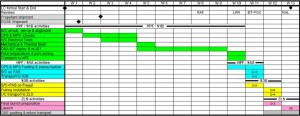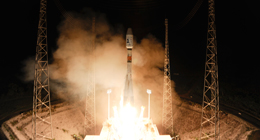The Gaia spacecraft is now safely packed into its container at the Astrium premises in Toulouse where it was built, awaiting its departure end of this week for the launch site.
The next time, we’ll see the satellite will be at Europe’s Spaceport in French Guiana. Exciting! Giuseppe will report on the happenings and send pictures from the arrival directly from Kourou next week.
In the meantime, let’s have a look at the next steps.
In total, some 70 people from ESA and Astrium will be in Kourou, working in two shifts, Monday to Saturday, to get everything ready for launch. Until the launch window opens on 17 November, there are plenty of things to do.
The below schedule provides an overview of the planning of the weekly activities. No dates are indicated, the weeks are numbered towards launch. Week #1 marks the arrival of the spacecraft in Kourou on 23 August.
Once the spacecraft has arrived, it will undergo mechanical and electrical testing, as well as several chemical and micro-propulsion checks. Afterwards, the sunshield will be fully deployed. Those activities will be done in the same building where also Planck was finally integrated before it was launched in May 2009 together with Herschel. In the schedule, they are coloured in green.
Then, Gaia will be moved to the Hazardous Payload Facility – a cleanroom where the spacecraft will be fueled which is a safety critical operation.
The activities in yellow are done in a location called S3B. They include the integration of the spacecraft onto the adaptor, then onto the Fregat upper stage (the fourth stage of the launcher) and finally the encapsulation into the fairing.
The final activities are at the launch pad. There, the fairing containing the spacecraft will be mounted on top of the rocket.
Detailed explanation of the colour code and the acronyms used:
PPF, where all activities in green are done, means Payload Preparation Facility. It is the clean room where the final integration and check of the spacecraft are completed, before loading of the propellant in the tanks.
HPF, activities in blue, means Hazardous Payload Facility. Here the spacecraft will be loaded with fuel.
The activities in yellow are done in a location called S3B with S3B indicating the number of the building. Other building numbers mentioned in the timeline are S1B (green activities) and S5B (blue activities).
Last is the ZLS (activities in pink) which means Zone Lancement Soyuz. That’s the launch pad. There, the fairing containing the spacecraft will be mounted on top of the rocket.
Acronyms:
CPS = Chemical Propulsion System
MPS = Micro-Propulsion System
DSA = Deployable Sunshield Assembly
I & T = Integration & Test
PAS = Payload Adapter System
UC = Upper Composite
GSE = Ground Support Equipment



Discussion: no comments